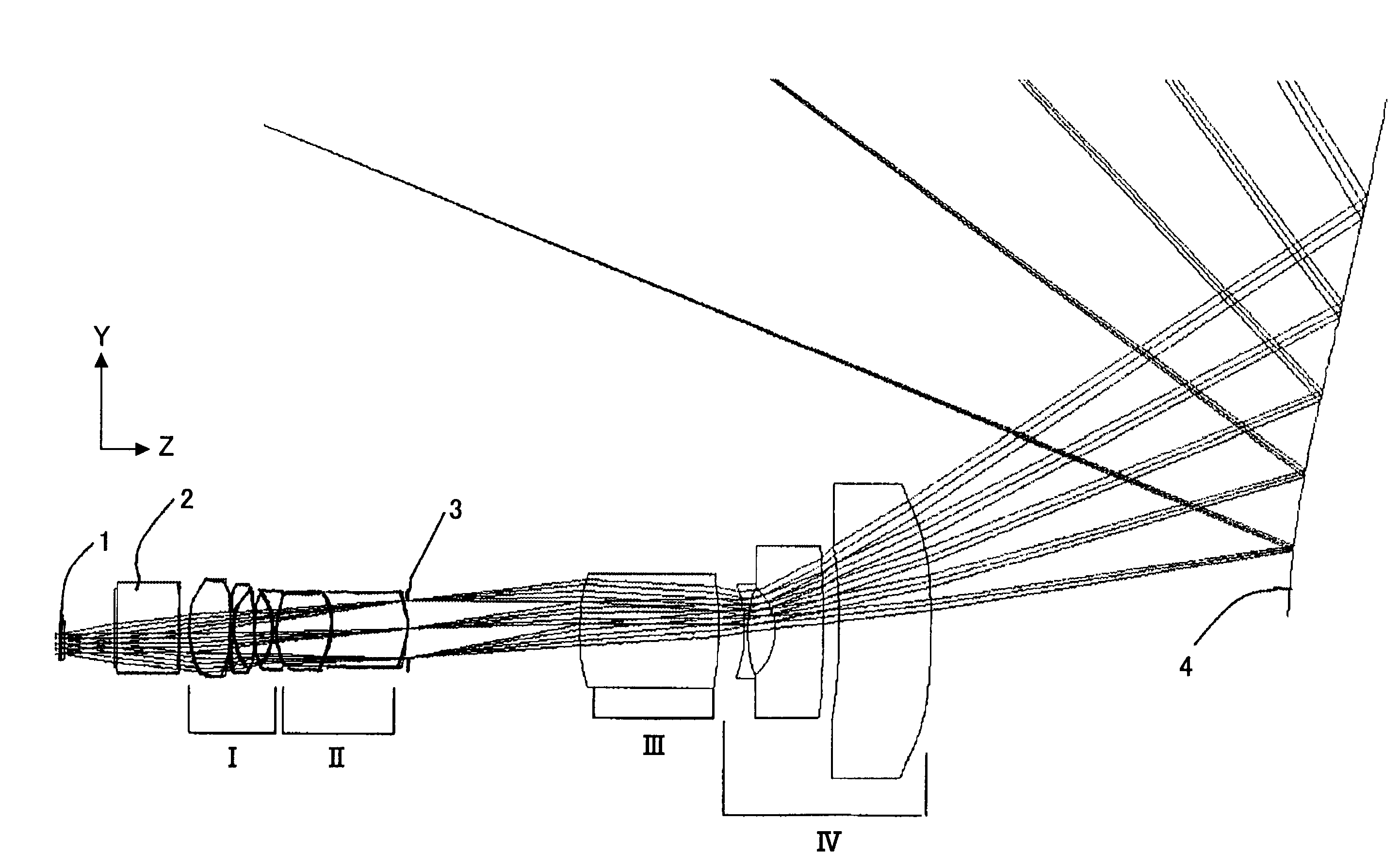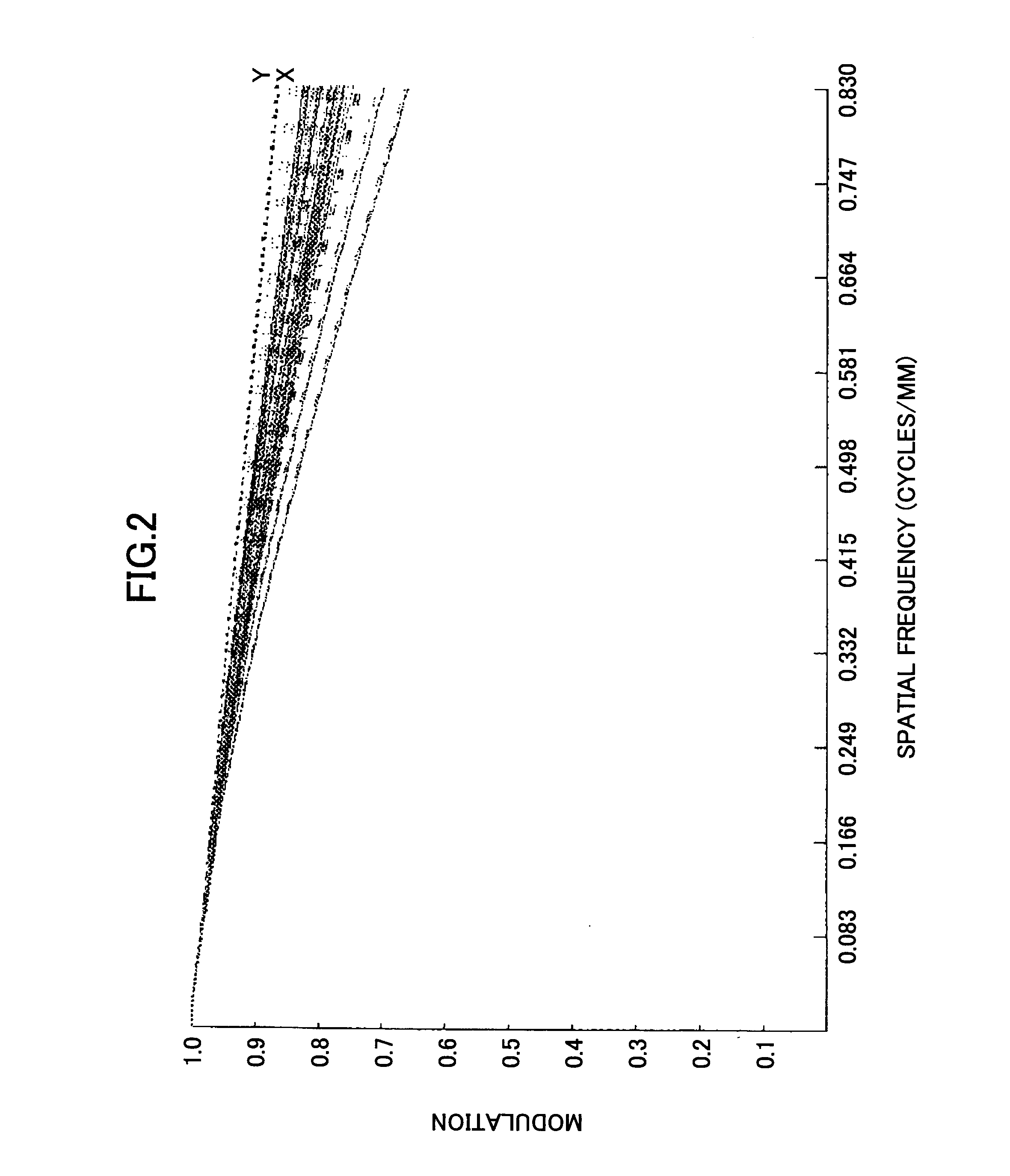Projection optical system and image display apparatus
a technology of projection optical system and image display apparatus, which is applied in the direction of optical elements, lenses, instruments, etc., can solve the problems of increased cost, difficult manufacturing of mangin mirrors, and inability to readily apply to reflective light valves such as lcos
- Summary
- Abstract
- Description
- Claims
- Application Information
AI Technical Summary
Benefits of technology
Problems solved by technology
Method used
Image
Examples
numerical example 1
[0087]Table 1 shows data on numerical example 1.
[0088]In Table 1, “No.” is a surface number from the object side including both sides of the transparent plate referenced at reference numeral 2 and a surface of the diaphragm 3. No. 0 indicates the object surface and No. 15 indicates the surface of the diaphragm 3. R indicates radius of curvature, D indicates a space between surfaces, Nd indicates a refractive index of a material relative to d line, and vd indicates an Abbe number.
TABLE 1No.RDNdνdNote00.0027.25Objectsurface10.0036.901.51764.120.004.85345.1122.411.49781.64−126.860.105183.631.601.78644.2631.3110.991.49781.67−145.020.10871.1310.391.49781.69−33.791.601.83437.11050.680.101147.3129.421.62036.312−36.810.2413−35.3640.691.48870.414−71.370.10150.0092.73Diaphragm16104.7775.051.77349.617−195.6814.0418−71.181.601.60360.51966.4415.0020−31.0726.221.69636.221−497.888.12220.0049.501.49257.8Asphericalsurface230.00192.49Asphericalsurface24−133.33−250.00Asphericalsurface250.00300.00Refle...
numerical example 2
[0119]Table 5 shows data on numerical example 2.
[0120]In Table 5, “No.” is the surface number from the object side including both sides of the transparent plate referenced at reference numeral 2 and the surface of the diaphragm 3. No. 0 indicates the object surface and No. 15 indicates the surface of the diaphragm 3. R indicates radius of curvature, D indicates the space between surfaces, Nd indicates the refractive index of the material relative to d line, and vd indicates an Abbe number.
TABLE 5No.RDNdνdNote00.0027.25Objectsurface10.0036.901.51764.120.004.85354.5810.391.49781.64−147.7013.485203.761.601.78644.2635.189.551.49781.67−145.330.10897.129.451.49781.69−35.549.181.83437.110−420.4921.9611−1041.309.831.62036.312−63.984.0713−58.6910.001.48870.414−67.20114.08150.00112.59Diaphragm1696.148.321.77349.617−566.0132.5218−66.6810.001.60360.51969.0018.9520−32.647.061.69636.221−134.3527.11220.0013.751.49257.8Asphericalsurface230.0058.88Asphericalsurface24−133.33−274.16Asphericalsurface25...
numerical example 3
[0165]Tables 9, 10, and 11 show data on numerical example 3.
[0166]In Table 9, surface number is a number from the object surface including both sides of the transparent plate 2 in FIG. 9. Surface 1 (S0) indicates the object surface, surfaces 11 to 17 (S11 to S17) indicate the first lens group I, surface 19 (S19) indicates the diaphragm, surfaces 20 to 23 (S20 to S23) indicate the second lens group II, surfaces 24 to 25 (S24 to S25) indicate the third lens group III, surfaces 26 to 31 (S26 to S31) indicate the fourth lens group IV, surface 32 (S32) indicates an aspherical mirror, surface 33 (S33) indicates a plane mirror for returning, and surface 34 (S34) indicates the image surface. Surfaces 30, 31, and 32 indicate aspherical surfaces. “INF” indicates a plane. The above-mentioned description of Table 9 applies in the following tables (13, 17, 21, 25, 29, 33, 37, 41, 45, 49, 53, 57, 61, 65, 69, and 73) in the same manner.
TABLE 9CurvatureAbbeSurfaceradiusSpaceRefractivenumbernumber(m...
PUM
 Login to View More
Login to View More Abstract
Description
Claims
Application Information
 Login to View More
Login to View More - R&D
- Intellectual Property
- Life Sciences
- Materials
- Tech Scout
- Unparalleled Data Quality
- Higher Quality Content
- 60% Fewer Hallucinations
Browse by: Latest US Patents, China's latest patents, Technical Efficacy Thesaurus, Application Domain, Technology Topic, Popular Technical Reports.
© 2025 PatSnap. All rights reserved.Legal|Privacy policy|Modern Slavery Act Transparency Statement|Sitemap|About US| Contact US: help@patsnap.com



